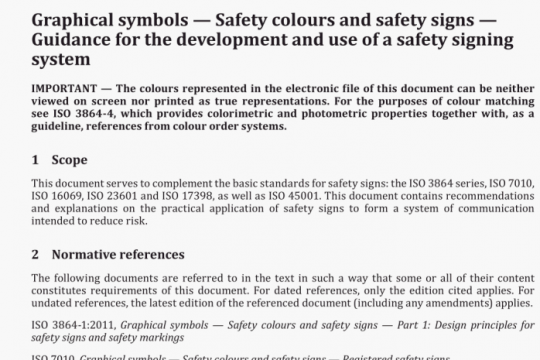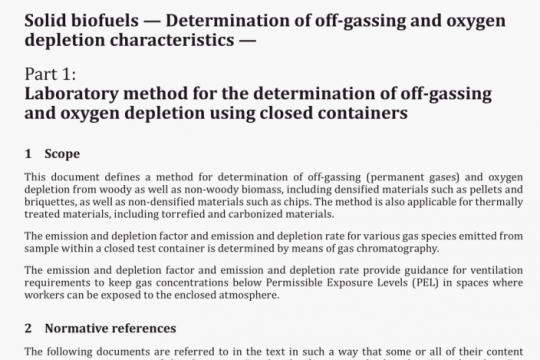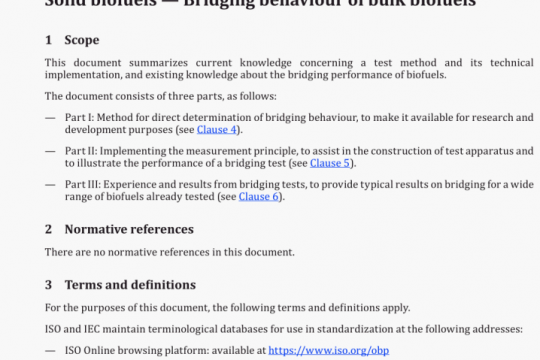EN ISO 20418-3 pdf free download
EN ISO 20418-3-2020 pdf free download.Textiles – Qualitative and quantitative proteomic analysis of some animal hair fibres – Part 3: Peptide detection using LC-MS without protein reduction [ISO 20418-3:2020].
7 Apparatus
The usual laboratory apparatus and, in particular, the following.
7.1 Heating mantle, capable of operating at a temperature range of SO °C to 150 °C.
7.2 Mill, beads mill, cryogenic grinder or an equivalent, capable of crushing materials into an extremely fine powder.
7.3 Membrane filter, for aqueous solutions, with a pore size of 0,45 I.Lm.
7.4 Heat block, capable of heating microtubes at 37°C.
7.5 Tube mixer, capable of vortex microtubes and LC vials for about 30 mm.
7.6 Centrifugal evaporator, capable to deliver 5 000g.
7.7 LC-MS, liquid chromatography—mass spectrometer. capable of detecting m/z (u) range from
200 m/z(u)to 1 500 m/z(u).
NOTE (u) is for unified atomic mass unit, SI unit.
7.8 LC vial, shall be glass or polymethylpentane.
7.9 IC column, octadecyl (C-18)-silica reversed phase column.
7.10 Balance, with a resolution of at least 0,001 g.
7.11 Recovery flask (eggplant flask or round-bottom flask).
8 Test method
8.1 Sampling
The general requirement is that the test specimen shall be representative for the lot of material from which it is taken. The method to obtain a fibre test specimen differs depending on the sample form. The terms relating to sampling for the various types of samples shall be in accordance with ISO 1833-1.
8.2 Preliminary identification
The preliminary qualitative analysis of the animal hair fibre shall be carried out based on their morphology, which is determined using light microscopy, according to ISO 17751 (all parts), after removal of non-animal fibre.
8.3 Wash for degreasing
8.3.1 Reflux I g of the fibres in a recovery flask (711) on a heating mantle (71) with 200 ml of acetone (b.1) for 30 mm. This washing step may be omitted in the case of clean samples. Quantity of the fibres can be changed.
8.3.2 Take the degreased fibres out of the recovery flask and dry them in the air. Alternatively, the sample preparation method of ISO 2O418-1[] can be used.
8.4 Powderization of fibres
Crush the dried fibre sample (8.32) using a mill (72) to get a fine powder with an average length of 100 I.lm or less by checking under the microscope and mix thoroughly for securing representative sampling of the fibres.
8.5 Trypsin digestion
8.5.1 Weigh about 10 mg of the crushed sample and place it into a microtube. If more than 10 mg of the sample is used, increase the volumes of the NH4HCO3 solution in BiZ and Trypsin solution in 8i proportionally.
8.5.2 Add 300 uI of the NH4FICO3 solution () and vortex for 10 mm to 30 mm.
8.5.3 Add 10 itl of the Trypsin solution (Z) to the sample and incubate at 37 °C for 20 h to 24 h.
8.5.4 Centrifuge the tryptic solution for 3 mm using the centrifugal evaporator (76). Filter the supernatant through a membrane filter (73) to remove residual fibres.
NOTE Centrifugal filter, syringe filter or other means of filtration can he used.
8.5.5 Transfer the solution to an LC vial, then dry it using the centrifugal evaporator (L6). If the LC vial does not fit in the dryer, the solution can be dried in other types of container such as a microtube. The sample is transferred to an LC vial after dissolution. Alternatively, a freeze dryer or nitrogen flux can be used as the drying method, instead of the centrifugal evaporator.
8.5.6 Add 40 i.il of water containing 0,1 % formic acid and 5 % acetoriitrile and vortex for 30 mm, for subsequent LC-MS measurements. Sonication shall not be a substitute for vortex when LC-MS sample Is dissolved.
8.6 Marker peptides
8.6.1 Select the peptides which are used as markers for differential identification of fibres, as specified in Annex A and Annex C. The result of the preliminary identification by microscopy (thZ) and Table 1 can be used as references for this selection.EN ISO 20418-3 pdf download.




